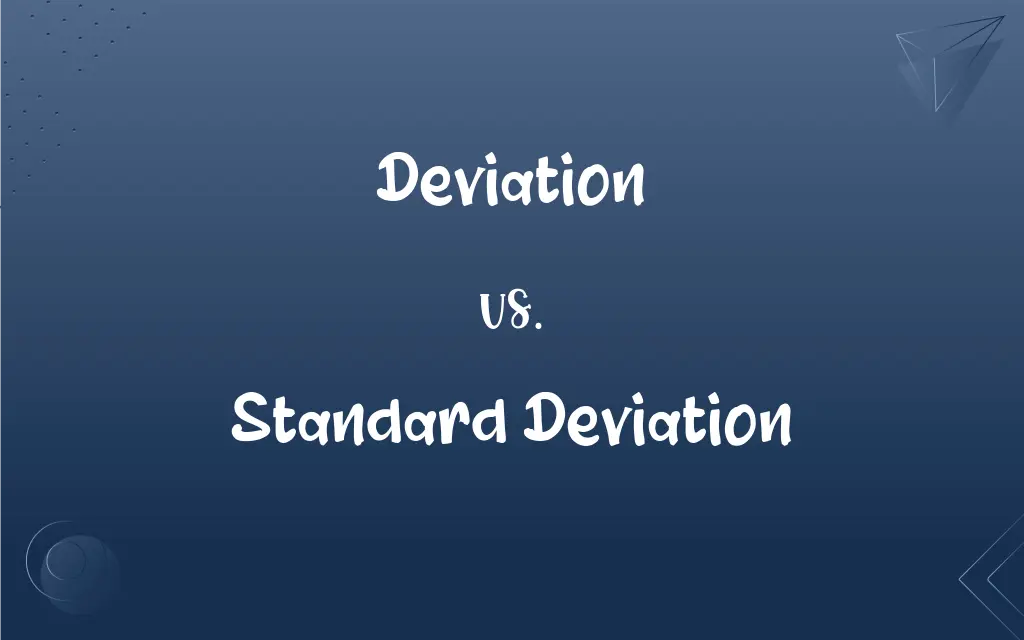Deviation vs. Standard Deviation: What's the Difference?
Edited by Harlon Moss || By Janet White || Published on December 28, 2023
Deviation is a measure of the difference between a single value and a fixed point, often a mean. Standard Deviation is a statistical measure quantifying the amount of variation or dispersion in a set of values.

Key Differences
Deviation in statistics refers to the difference between an observed value and the mean of a dataset. It indicates how far a particular data point is from the average. Standard deviation, on the other hand, is a measure that quantifies the amount of variation or dispersion of a set of data values from the mean.
A deviation can be positive or negative, depending on whether the data point is above or below the mean. It is a simple, straightforward calculation. Standard deviation, however, is calculated by taking the square root of the average of the squared deviations from the mean, providing a more comprehensive measure of spread.
Deviation helps in understanding the dispersion of individual data points. It is a basic concept used in various statistical calculations. Standard deviation, as a derived measure, provides insight into the overall variability within a data set and is key in risk assessment and quality control.
Deviation is a measure of distance without any standardization, standard deviation is a standardized measure, often used to compare the spread of different datasets. While, standard deviation is particularly useful in comparing the spread of data sets that have different means or units.
Deviation is a simpler concept, focusing on the distance of a single data point from the mean, whereas standard deviation is a more complex, aggregate measure reflecting the overall dispersion of a data set.
ADVERTISEMENT
Comparison Chart
Definition
Difference between a single value and the mean
Measure of spread of all values from the mean
Calculation
Simple difference from the mean
Square root of the average of squared deviations
Indication
Individual data point’s dispersion
Overall dataset’s variability
Standardization
Non-standardized measure
Standardized measure
Usage
Basic statistical analysis
Advanced analysis, risk assessment
ADVERTISEMENT
Deviation and Standard Deviation Definitions
Deviation
Deviation in statistics is the departure of a value from the mean.
The deviation in rainfall this year compared to the average was quite noticeable.
Standard Deviation
Standard deviation is a measure of the amount of variation or dispersion in a set of values.
A low standard deviation indicates that the values tend to be close to the mean.
Deviation
Deviation is a measure of disparity between an individual data point and the average.
The deviation of his height from the team's average was remarkable.
Standard Deviation
Standard deviation is a statistical measure to understand the spread of data points.
The investment's high standard deviation suggested significant risk.
Deviation
Deviation represents how far a single measurement is from a central value.
Her test score showed a large deviation from the class average.
Standard Deviation
Standard deviation is the square root of the variance in a data set.
The high standard deviation showed greater spread in the data.
Deviation
Deviation is the difference between an observed value and a standard or mean value.
The deviation from the average temperature this month was significant.
Standard Deviation
Standard deviation quantifies the average distance of each data point from the mean.
The standard deviation in their test scores reflects a high variability in performance.
Deviation
Deviation quantifies the extent to which a number differs from a fixed point.
There was a significant deviation in the expected and actual sales figures.
Standard Deviation
Standard deviation indicates how dispersed the values in a set are from the average.
The low standard deviation in temperatures suggested a stable climate.
Deviation
The act of deviating or turning aside.
Deviation
An instance of this
"We made so many deviations up and down lanes ... that I was quite tired, and very glad, when we saw Yarmouth" (Charles Dickens).
FAQs
What does deviation measure in statistics?
Deviation measures the difference between an individual value and the mean.
What does a high standard deviation indicate?
A high standard deviation indicates greater variability among data points.
How is standard deviation calculated?
Standard deviation is calculated as the square root of the average of squared deviations from the mean.
How does deviation differ from variance?
Deviation is the difference from the mean, while variance is the squared average of these deviations.
Can deviation be negative?
Yes, deviation can be negative if the value is below the mean.
Is deviation used in calculating standard deviation?
Yes, standard deviation is derived from the mean of squared deviations.
What is the significance of standard deviation in risk assessment?
Standard deviation helps in assessing the volatility and risk in datasets.
Can standard deviation be used to compare different datasets?
Yes, it can compare the variability of datasets with different means or units.
What role does deviation play in data analysis?
Deviation helps in understanding the dispersion of individual data points.
What type of data requires standard deviation analysis?
Data with variability or spread, like test scores or investment returns, often require it.
Does a zero deviation mean no variation?
A zero deviation means the value is exactly at the mean, but doesn’t speak for the entire dataset.
Does a small deviation always mean low variability?
A small deviation indicates closeness to the mean for that specific value only.
Does standard deviation measure central tendency?
No, it measures spread or variability, not central tendency.
How does standard deviation relate to data spread?
Standard deviation quantifies the spread of data points around the mean.
How does sample size affect standard deviation?
A larger sample size can provide a more reliable standard deviation.
Is standard deviation always positive?
Yes, standard deviation is always positive or zero.
Can deviation be zero?
Deviation can be zero if the value is exactly equal to the mean.
How is deviation used in quality control?
Deviation is used to assess consistency and adherence to standards.
Why is standard deviation important in finance?
It's crucial for assessing the volatility and risk of investments.
What does a large deviation indicate?
A large deviation indicates that a value is far from the mean.
About Author
Written by
Janet WhiteJanet White has been an esteemed writer and blogger for Difference Wiki. Holding a Master's degree in Science and Medical Journalism from the prestigious Boston University, she has consistently demonstrated her expertise and passion for her field. When she's not immersed in her work, Janet relishes her time exercising, delving into a good book, and cherishing moments with friends and family.
Edited by
Harlon MossHarlon is a seasoned quality moderator and accomplished content writer for Difference Wiki. An alumnus of the prestigious University of California, he earned his degree in Computer Science. Leveraging his academic background, Harlon brings a meticulous and informed perspective to his work, ensuring content accuracy and excellence.































































